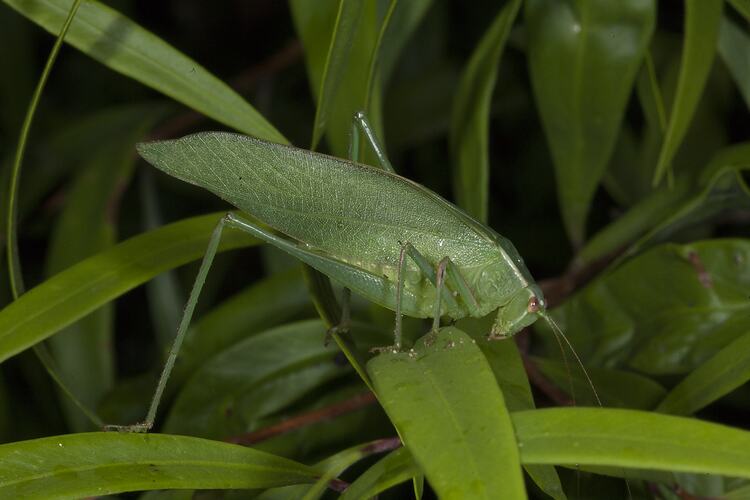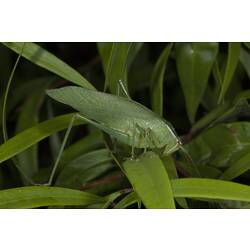General Description
A large, green, gangly insect with very long, thin hind legs, very long, wispy antennae and triangular head with downward-pointing mouthparts. Adults are winged; the green fore wings closely resemble leaves; they form a roof-like covering overlaying the abdomen and bear a network of paler veins, the outermost of which may be pink or yellow. The tip of the abdomen may also be pink or yellow. The female is stockier than the male, and her abdomen ends in a prominent egg-laying tube (ovipositor) shaped like an upcurved spike. Juveniles (nymphs) lack wings and may be green, brown or bright pink, generally mottled with darker and paler flecks. Adult body-length to 4 cm.
Biology
Insects in the cricket family Tettigoniidae are commonly called katydids or bush crickets. Adults and nymphs are primarily herbivorous, eating young foliage and petals. They seem to match their colour to suit their background (or vice versa), and rely on their camouflage for protection; they can also use their powerful hind legs to jump out of danger's way. Males have stridulatory organs on their wings, producing an audible but feeble chirping call on warm evenings to attract mates. The female uses her ovipositor to lay eggs in plant-stems.
Distribution
Australia.
Habitat
Lives amongst foliage, and found almost anywhere where trees or bushes grow, particularly regrowth areas and established gardens.
More Information
-
Animal Type
-
Animal SubType
-
Brief Id
Insects in the cricket family Tettigoniidae are commonly called katydids or bush crickets. They have very long antennae.
-
Colours
Green, Pink
-
Maximum Size
4 cm
-
Habitats
-
Diet
Herbivore
-
Endemicity
-
Commercial
No
-
Conservation Statuses
CITES: Not listed, FFG Threatened List: Not listed, EPBC Act 1999: Not listed, IUCN Red List: Not listed
-
Taxon Name
-
Scientific Author
(Walker, 1869)
-
Common Name
Common Katydid
-
Kingdom
-
Phylum
-
Subphylum
-
Class
-
Order
-
Family
-
Genus
-
Species Name
simplex



